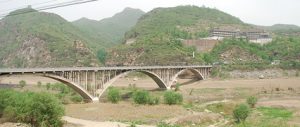Beijing’s lack of water is making it jumpy. Early in the morning of 14 June, a team of 12 researchers from the city’s water authority and urban planning commission travelled several hundred kilometres to Caofeidian – a land reclamation project on the coast of Hebei province – and then to the city of Tianjin, south-east of Beijing, to assess the possibility of transferring desalinated sea water to the capital.
This summer, following 12 consecutive years of drought, Beijing’s daily water supply has fallen to a maximum of 3 million cubic metres. The city – whose per capita water resources are a tenth of the world average – is already in the grip of a severe water crisis.
On 9 May, Beijing clearly stated its intention to include in its strategic plans the diversion of water from the Yellow River to the capital and the use of desalinated water and karst water. This was the first time that Beijing explicitly said desalination would form part of its water-resource strategy.
“If Beijing shows determination now, we can supply them with water by 2013,” said Zhu Yueji, deputy director of the Caofeidian Industrial Management Committee. According to his plan, two pipelines, each approximately 1.5 metres in diameter, will pass through two pumping stations and then carry desalinated Bohai Sea water directly to eastern Beijing, 220 kilometres away.
Tianjin is another desalination centre and already has the Beijiang and Dagang plants, the country’s two largest desalination projects which together account for a third of the nation’s capacity. In the words of Zhou Chaohong, chief engineer at the Tianjin Water Resources Institute, the city is “not quite ready” for the large-scale transfer of desalinated sea water into the municipal water supply. Nevertheless, Tianjin has set out clear plans to 2015, by which time it will have doubled its desalination capacity to 480,000 tonnes per day. “Maybe we can send some of that to Beijing,” said Zhou.
The latest urban water crisis has been a shot in the arm for the nascent desalination industry. In April, ministers from the Ministry of Science and Technology attending an international conference on water technology revealed that China is currently building several large-scale desalination projects with 50,000-tonne capacity or above. The desalination programme under China’s 12th Five-Year Plan is being led by the National Development and Reform Commission, the country’s top economic planner, and includes plans to set up industry hubs in coastal cities such as Tianjin, Dalian and Qingdao.
At present, the price of desalinated water from Caofeidian is already reported to be lower than 6 yuan (US$0.92) per tonne and it is likely that this will drop further. According to Li Zhangjian, the former director of the Tianjin Desalination Institute, price is not really a problem for desalination, especially in comparison with the impending South-North Water Transfer Project.
Li pointed out that, in 2002, the then leader of the Ministry of Water Resources said that, once you take into account the cost of coastal land reclamation, relocating displaced people, project oversight and ecological damage caused by water diversion, then the cost per tonne of water from the South-North Water Transfer Project will be approximately 20 yuan (US$3). “Even if the cost of desalination rises, it still won’t reach 20 yuan,” Li said, ruefully.
The State Council office in charge of the mega engineering scheme has not yet published an accurate structure for water pricing. This makes a meaningful comparison between desalination and the South-North Water Diversion Project difficult.
In an article published in the People’s Daily on April 1, Wang Huisheng, chairman of the board of the State Development Investment Corporation, said that desalination technology already has the conditions for widespread application. He added that its costs were not large compared with long-distance water transfer and proposed that, while a strategic policy decision regarding the large-scale inter-river basin water diversion project is being made, comparative research with desalination should also be carried out.
The State Development Investment Corporation is an investor in China’s largest domestic desalination project – the Tianjin Beijiang Power Plant. The question is: how much of this high-profile campaign is aimed at plugging the unexpected gap in Beijing’s water supply after the delay in the South-North Water Transfer Project?
At the end of 2008, the timetable for the project’s central route was adjusted, and the date by which it will transfer river water to Beijing and Tianjin moved from 2010 to 2014. The deadline for water transfer through the eastern route had already been moved back six years to 2013. In 2009, when news spread of the delays, Guo Youzhi, secretary general of the desalination branch of the China Association of Water Enterprises, went to the Beijing Water Authority to ask about the capital’s water shortage situation. A contact there told him: “I cannot explain how desperate it is.”
The same year, Guo proposed that a desalination project be launched as soon as possible in order to relieve Beijing’s water woes. On account of this, he was named “Man of the Year 2009” by Science and Technology Daily.
It was also at the start of 2009 that the relative pros and cons of the South-North Water Transfer Project and desalination began to be weighed against each other. In June 2010, there was a rumour that the price of water from the transfer scheme would be as high as 8 yuan to 10 yuan (US$1.2 to US$1.5), but the acting head of the project’s management office came forward to refute this. At the end of 2010, a gathering of experts on water transfer and desalination focused their discussions on the key issues of cost reduction and feasibility.
To date, the question of how to set the price of water from the South-North Water Transfer Project has been hashed out on the ground between investment interests and government policy. “The way in which the price has been calculated is unclear and nobody has been able to understand it,” said an industry professional who is familiar with the research process at the office in charge of the scheme.
The more people debate whether transferring water or desalinating water is a better option, the less clear it becomes – and we’ve ended up with a situation where each side is unwilling to carry out a comparison in order to avoid confrontation. In the winter of 2010, at a forum organised by the office of the South-North Water Transfer Project, participants declined to draw any direct comparisons between the cost of the diversion scheme and desalination, even though there was strong public interest in the matter.
An official from the State Oceanic Administration who has been inspecting early-stage coastal desalination projects since the early 1990s told us he has no doubts about the economic feasibility of the main South-North Water Transfer Project, but harbours misgivings about the project’s eastern route. The bulk of the water from the eastern channel will go to Tianjin and Shandong province – an area that happens to be near the Yellow Sea and the Bohai coastal zone. “Why wouldn’t you make use of nearby resources to solve the water troubles of these coastal regions?” the official asked.
He bluntly added that, historically, almost all east-west water diversion projects have proved unsuccessful, including: diverting the Luan River to Tianjin, diverting the Yellow River to Qingdao and diverting the Biliu River to Dalian.
Zhou Chaohong recently took part in a desalination research project at the Tianjin Development and Reform Commission. She didn’t compare desalination and the South-North Water Diversion Project, saying only: “There is no single water resource capable of ensuring the safety of our water supply.”
In the 1970s, China began to make use of desalination technology on islands and military ships. But it was not until the turn of the century that, thanks to corporate input, medium-sized desalination facilities were successfully made to work in various coastal power plants and other enterprises.
However, so far, all successful desalination projects are used privately by these operations. According to figures from the China Desalination Association, the country has 69 desalination facilities, with planned production capacity of 680,000 tonnes a day but, in reality, producing probably only 400,000 to 500,000 tonnes – and not even reaching the scale of a single Middle Eastern desalination plant. At present, optimistic predictions of the China Desalination Association are that in the next five years the nation’s desalination output will reach 1.4 million tonnes: 500,000 tonnes of capacity is under construction.
Li Zhang believes that whether or not the desalination approach is adopted depends on how urgently it is required: “If the South-North Water Transfer Project does not come to pass and Beijing’s Miyun Reservoir dries up, then they won’t care how much it costs.”
Feng Jie is a reporter and Shi Qiujuan an intern at Southern Weekend, where this article was originally published. Another intern, Sheng Zhangqing, also contributed.
Homepage image from Greenpeace shows Beijing’s Miyun Reservoir.

